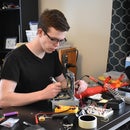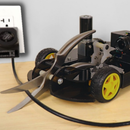Introduction: Wooden Steampunk USB
This is relatively easy project that would be great for giving as gifts or just keeping for yourself. If you don't want to use a large and expensive USB it is not too uncommon to find free, small storage (2 to 8gb) USB's at various promotional events, fairs and conventions.
Step 1: Materials and Tools
Materials
- Scrap parts from old mechanical watches, you can salvage your own, I personally bought these (there may be cheaper/ faster shipping options on other websites too).
- Scrap wood, I personally used a piece of Sheoak
- USB (the ones you get at conventions/fairs etc. are cheaply made and are easy to open but have limited space)
Tools
- Router with 1/2" and 9/16" bits
- Bandsaw
- Various grit sandpaper
- Wood glue
- Polyurethane varnish
- Super glue
Step 2: Make the Wooden Case
The scrap wood I used was 13.5mm in height, resulting in a USB that was 12.8mm high (the loss of 0.7mm comes from the bandsaw, as detailed later). I would suggest that the minimum height of the wood should be 9.4mm otherwise you will start losing structural integrity, conversely a thicker piece of wood leads to a bulkier USB. The width and length is irrelevant so long as there is enough space to make the USB case.
Start by attaching a 9/16" bit to the router so that it cuts away 2.5mm from the surface of a test piece of wood. Adjust the guide plate on your router such that when the wood is pushed the router cuts away in the centre of the wood piece and not off to one side (see above pictures). Cut away the space in the wood for the internal part of the USB, overshoot (it is easy enough to cut away excess wood later). Flip the wood over so that you cut away the wood directly under your first cut. Do the same thing for the USB cap, however with a 1/2" bit instead.
Using a bandsaw cut down the centre of the wood piece in between the 2 sides of the router cut. Cut out the USB case. I personally used a wall thickness of 4mm, but vary it as you wish. One possibility could be curves and contours instead of a rectangular prism shaped case. Sand the individual pieces and then glue them together. Sand them again this time starting with a low grit (I used 80) and moving higher (I went to 240), make sure there are no obvious join marks/ridges.
Step 3: An Alternative Approach
I realize not everyone has access to a router so 2 other options could be:
1) Use a Dremel, drill or similar to remove the space for storing the USB. I actually used this technique when prototyping, though there are a few imperfections, it still worked well.
2) A theoretical approach (I haven't tested it but I see no reason it can't work) would be to cut thin strips of wood 3 to 4mm thick and glue them into two open ended boxes, one for the USB and one to act as a lid. Gluing might be tricky (getting everything to stay still) but it would also enable you to experiment with different types of wood, colour and textures (in the pictures above, one of the USB's I made was with a really nice textured wood, I decided not to sand the top and bottom faces and instead leave the grooves and bumps).
Comment down below any other approaches you can think of, it could help others!
Step 4: Finishing
After the cases had dried I sanded the surfaces with a 600 grit sandpaper and then applied a thin coat of Polyurethane varnish. After letting it dry I sanded it again and reapplied the varnish and once dry I gave it a light sanding with 800 grit. If you want you could go to higher grits and get a better finish but I was satisfied.
Before gluing the USB in place, check that it still works as it might have been damaged while exposed. Glue in the USB and test that the lid fits snugly (you don't want it either too tight nor too loose).
If you want you could leave it at this, and have a beautiful wooden USB, however I decided to superglue some extra clock pieces on. There is no real explanation required for the technique other than let your imagination go free and play with several compositions before committing to any specific one in particular. If you decide to glue something other than clock parts on let me know in the comments below, I would be interested to see!

Participated in the
MacGyver Challenge













